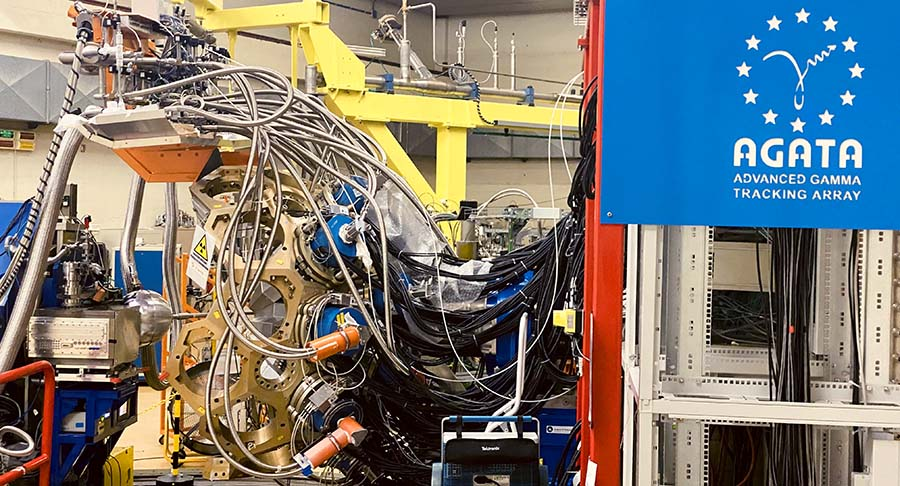The nickel isotopes offer a unique laboratory to investigate shape evolution in the vicinity of doubly-magic N=Z nucleus, $^{56}$Ni (Z=N=28), which should exhibit similar structural properties to those observed in the Z=N=20 region. Indeed, observation of the SD structures was reported also in $^{56}$Ni, explained as the result of $mp-mh$ excitations like in the case of $^{40}$Ca [3]. However,...
In this contribution, we will present the current state of the analysis of experiment 23.003, aimed at the measurement of the lifetime of the 6.793 MeV excited state of 15O with sub-fs uncertainty. This experiment has strong astrophysical implications, as the lifetime we aim to measure strongly influences the value of the S-factor at Gamow-window energies for stars like our Sun. The experiment...
We present recent AGATA-PRISMA results on multi-nucleon transfer reactions induced by 22Ne and 26Mg beams on a 238U target at LNL. The experiments aim at exploring the boundaries of the N = 20 Island of Inversion by following the evolution of negative parity states originating from fp shell excitations, locating excited intruder configurations, and tracking the...
Lifetime measurements are commonly used to unravel the nature and properties of nuclear states, as they are closely related to transition probabilities, which provide information on the nuclear wave functions. The aim of the experiment here presented was to study the interplay of spherical (0 ℏω) and intruder (2 ℏω) configurations in the low-lying states of isotopes on the edge of the N=20...
The disappearance of the N=20 shell closure in the so-called “island of inversion” around $^{32}$Mg is one of the most striking examples of the strength of nucleon-nucleon correlations. In this region, the quadrupole-deformed intruder configuration (based on a multi-particle multi-hole configuration) becomes the ground state, subverting the expected shell ordering predicted by a harmonic...
The pairing interaction, responsible for the two-nucleon correlation, plays a fundamental role in defining the low-energy spectra of atomic nuclei and the properties of their ground state. The effect of pairing correlations in the reaction dynamics can be explored by using heavy-ion reactions, in particular those involving a transfer of few nucleons. In this context, an interesting analogy...
The experiment 22.18 was performed to study the nucleus $^{96}$Zr utilising the $\gamma$-ray tracking spectrometer AGATA coupled with the heavy-ion detector array SPIDER at INFN-LNL. This experiment is extremely timely in order to provide directly the $3^-_ 1 \rightarrow 0^+_1$ $\gamma$-ray transition probability for the first time. Previous measurements suggested that the $\gamma$-ray...
Report on the AGATA experiment number 23.061
Spokespersons: M. Zielińska, F. Ercolano, N. Marchini, J.J. Valiente Dobón
In this talk, I will report on the recent “Combined lifetime and transition-probability measurements in 96Zr via Coulomb excitation” experiment, conducted using the AGATA + PRISMA + Plunger detector setup during the May 23-29, 2024 beamtime. The primary aim of the...
For several decades, stable even-mass Cd isotopes have been considered to be textbook examples of multiphonon spherical vibrators [1] based on the excitation energy pattern of their low-lying states. However, a detailed study of $^{110}$In $\beta$ decay and subsequent beyond-mean-field theoretical calculations [2-5] suggested instead the presence of multiple shape coexistence in $^{110}$Cd...
In December 2022, an experiment was performed at INFN-LNL with a $^{208}$Pb beam at 1300 MeV impinging on a $^{9}$Be target, using the inverse kinematics fusion-fission reaction for both nuclear structure and reactions studies. The experiment was performed using the AGATA $\gamma$-ray tracking array coupled to the magnetic spectrometer PRISMA [1–3]. This setup allowed one to measure the...
With the AGATA-PRISMA setup at INFN Legnaro, the experiment "Pathway to nuclear structure in heavy neutron rich nuclei in the vicinity of N=126 and nuclei northwest of $^{132}\text{Sn}$ via multinucleon transfer reactions" was carried out to measure excited states to answer open questions in these regions of the nuclear chart. A primary $^{136}\text{Xe}$ beam with an energy of 1GeV hitting a...
This presentation explores results from two experiments, EXP_017 (23.015) and EXP_022 (22.096), focussing on high-spin states in $^{136,137}$Nd and octupole deformation in uranium isotopes, respectively.
In EXP_017, the investigation centered on the decays out of highly deformed rotational bands in $^{136}$Nd and $^{137}$Nd. These bands challenge existing nuclear structure theories by...
The experiment 23.015 performed in October 21-26, 2023 was devoted to the search for the decay out of an extremely regular rotational band in $^{137}$Nd, interpreted as built on oblate shape, that extends to a spin of about 75/2 and an excitation energy of 4.5 MeV above yrast at the highest spins. We measured 7 days with the $^{33}$S+$^{110}$Pd reaction at 180 MeV and the AGATA+EUCLIDES setup....
Recent calculations have suggested that the region of strong octupole correlations in the
light actinides extends to higher Z values than previously thought, with neutron-deficient
plutonium (Z = 94) and curium (Z = 96) nuclei predicted to have large β 3 values in their
ground states [1, 2]. In order to test the predictions, an experiment has been performed
to study the structure of...

